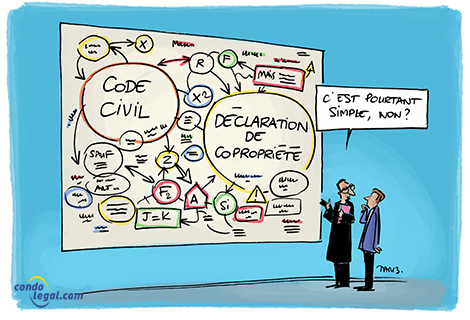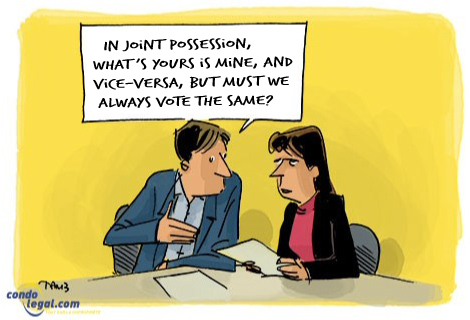
If you are shopping for an apartment, ask yourself if it is located in a divided or undivided co-ownership. Although these two concepts are similar, as they ultimately aim to share the same building by several people called co-owners, the legal and financial implications are not the same. These two types of co-ownership thus have very different terms of ownership, ownership and liability between the co-owners of a building. A look at the main distinctions between divided co-ownership and undivided co-ownership.
DIVIDED CO-OWNERSHIP
Divided co-ownership, also called condominium, is a residential arrangement which, from a legal standpoint, financially dissociates the owners from one another. It is necessarily governed by a declaration of co-ownership, a notarized agreement that regulates, in the immovable, the relationship between the co-owners and the Directors. The declaration of co-ownership is an essential legal document of the co-ownership because it contains the elements constituting its framework. Once published at the land registry office, the syndicate is automatically created under the Law.
To set up a divided co-ownership, the immovable must be divided in private and common portions. They are identified by a separate lot number attributed during a cadastral operation. Each of the private lots of the co-ownership so created becomes a separate lot.
Therefore each co-owner is the exclusive owner of his privative portion (i.e. apartment) and also, in some cases, of a parking space and/or a locker. The co-owners also own in common (in indivision) the common portions of the building, such as the major components of the building, mechanical equipment, lobby, swimming pool, parking, elevator(s) and community rooms. These common portions are managed by the syndicate of co-owners who must ensure their maintenance and preservation.
The legal regime of divided co-ownership gives owners more latitude, as one should theoretically be able to dispose of its property as he see fit, such as renting or selling his private portion without having to obtain prior authorization. You may also obtain a hypothecary loan to purchase your apartment, and the other co-owners will not be in any way responsible for it.
UNDIVIDED CO-OWNERSHIP
A building is held in undivided co-ownership when it is owned by more than one person, (the undivided co-owners) without being materially apportioned in distinct lots (private and common portions). The undivided co-ownership concept is very broad. It applies to spouses buying a house, to the members of a family who inherit a property, to three individuals purchasing jointly a triplex. In those three cases they are all undivided co-owners. Furthermore the shares of each undivided co-owners are deemed to be equal, unless the deed of sale or an indivision agreement provides differently.
 Contrary to divided co-ownership, the apartments are not individualized and it is not necessary to proceed with prior cadastral operations. The immoveable is the object of only one real estate evaluation. This is why the authorities issue only one tax bill for the entire immovable. You will own, with all the other co-owners, an undivided right of ownership in the entire immovable in proportion to the value of your share.
Contrary to divided co-ownership, the apartments are not individualized and it is not necessary to proceed with prior cadastral operations. The immoveable is the object of only one real estate evaluation. This is why the authorities issue only one tax bill for the entire immovable. You will own, with all the other co-owners, an undivided right of ownership in the entire immovable in proportion to the value of your share.
The indivision agreement
If divided co-ownerships are necessarily governed by a formal notarized agreement (declaration of co-ownership), undivided co-ownerships are not subject to this requirement. However, a written indivision agreement between the undivided co-owners will make quite a difference. It then becomes a structured undivided co-ownership.
The indivision agreement has many purposes: it deals more particularly with the identification of the share of the undivided co-owners and, as the case may be, the attribution on a portion of the immovable of an exclusive right of enjoyment and includes a description of the areas reserved for the exclusive use of the co-owners (i.e. the apartments or parking areas).In other words, you will be only a partial owner of the apartment in which you will reside. The other co-owners will be in a similar situation. Another object of the agreement is defining the rights and obligations of the parties. In most cases, the indivision agreement does not allow the rental of the apartments.
In order for an indivision agreement to be enforceable upon a new co-owner, it has to be registered at the land registry office, unless the rights contained in the said agreement have been transferred to the said co-owner and that the latter has assumed its obligations. Finally even though it may be renewed at all times, such agreements cannot have a term exceeding 30 years.
The solidary obligations of the co-owners
As a co-owner in an undivided co-ownership you will be responsible for many solidary obligations. If one of the co-owners fails to pay, the others must pay on his behalf. This is the case for real estate taxes, (municipal and school) for which the co-owners are solidarily responsible.
Also, in an undivided co-ownership, the financial institutions generally require the intervention of all the co-owners to grant a loan secured by a hypothec. Every co-owner (including yourself) then becomes jointly responsible for the repayment of the loan.
In the absence of an indivision agreement including provisions safeguarding the payment of the various obligations of each undivided co-owners, you are left to the vagaries of chance should one of the co-owners become insolvent.
The exception to the rule: limited liability Loans
However if you benefit from an appropriate indivision agreement, a few financial institutions offer limited liability hypothecary loans .Article 1015 of the Civil Code of Québec provides that each undivided co-owner may consent on its own a hypothec on his share of the immovable. Thus, the hypothecary debt of the latter towards his creditor is secured by a hypothec enforceable only against the undivided rights (share) owned by him in the immoveable. The other co-owners are not responsible of the debt of the co-owner, since as the present title indicates the liability for the payment of the loan is limited to the one co-owner who obtained it. In case of default, only the share of the co-owner concerned can be seized by the creditor.
The right to repossess the dwelling
The landlord can theoretically repossess the dwelling to inhabit it or to accommodate his children or his close family. However if you are in indivision with a person that is not your spouse, it is not possible for an owner to repossess a residential dwelling. Indeed article 1958 of the Civil Code of Québec states:
‘’The owner of an undivided share of an immovable may not repossess any dwelling in the immovable unless the only other owner is his or her spouse.’’
On the other hand, the protection in favor of the tenant does not apply to a sub-tenant.
 WHAT YOU SHOULD KNOW ! The Civil code of Québec, allows each undivided co-owner to obtain a separate hypothec binding only himself. In the present market, save for particular cases, only the National Bank of Canada and some Desjardins credit unions grant this type of financing, and even then only if an indivision agreement is registered on the immovable.
WHAT YOU SHOULD KNOW ! The Civil code of Québec, allows each undivided co-owner to obtain a separate hypothec binding only himself. In the present market, save for particular cases, only the National Bank of Canada and some Desjardins credit unions grant this type of financing, and even then only if an indivision agreement is registered on the immovable.
 WHAT TO KEEP IN MIND : The Civil code of Québec does not regulate to any extent the rights and obligations of undivided co-owners. Without an indivision agreement, none of you can claim having an exclusive right of occupation of a portion of the immovable in particular. To insure the drafting of an indivision agreement in which the rights, obligations and guaranties are clearly spelled out, it is important to consult a notary with experience in these matters.
WHAT TO KEEP IN MIND : The Civil code of Québec does not regulate to any extent the rights and obligations of undivided co-owners. Without an indivision agreement, none of you can claim having an exclusive right of occupation of a portion of the immovable in particular. To insure the drafting of an indivision agreement in which the rights, obligations and guaranties are clearly spelled out, it is important to consult a notary with experience in these matters.
 WARNING ! It is important to note that most indivision agreements do not allow rentals. For more information on the advantages and disadvantages of undivided co-ownership, consult the factsheet Undivided co-ownership: an alternative to condos?.
WARNING ! It is important to note that most indivision agreements do not allow rentals. For more information on the advantages and disadvantages of undivided co-ownership, consult the factsheet Undivided co-ownership: an alternative to condos?.







